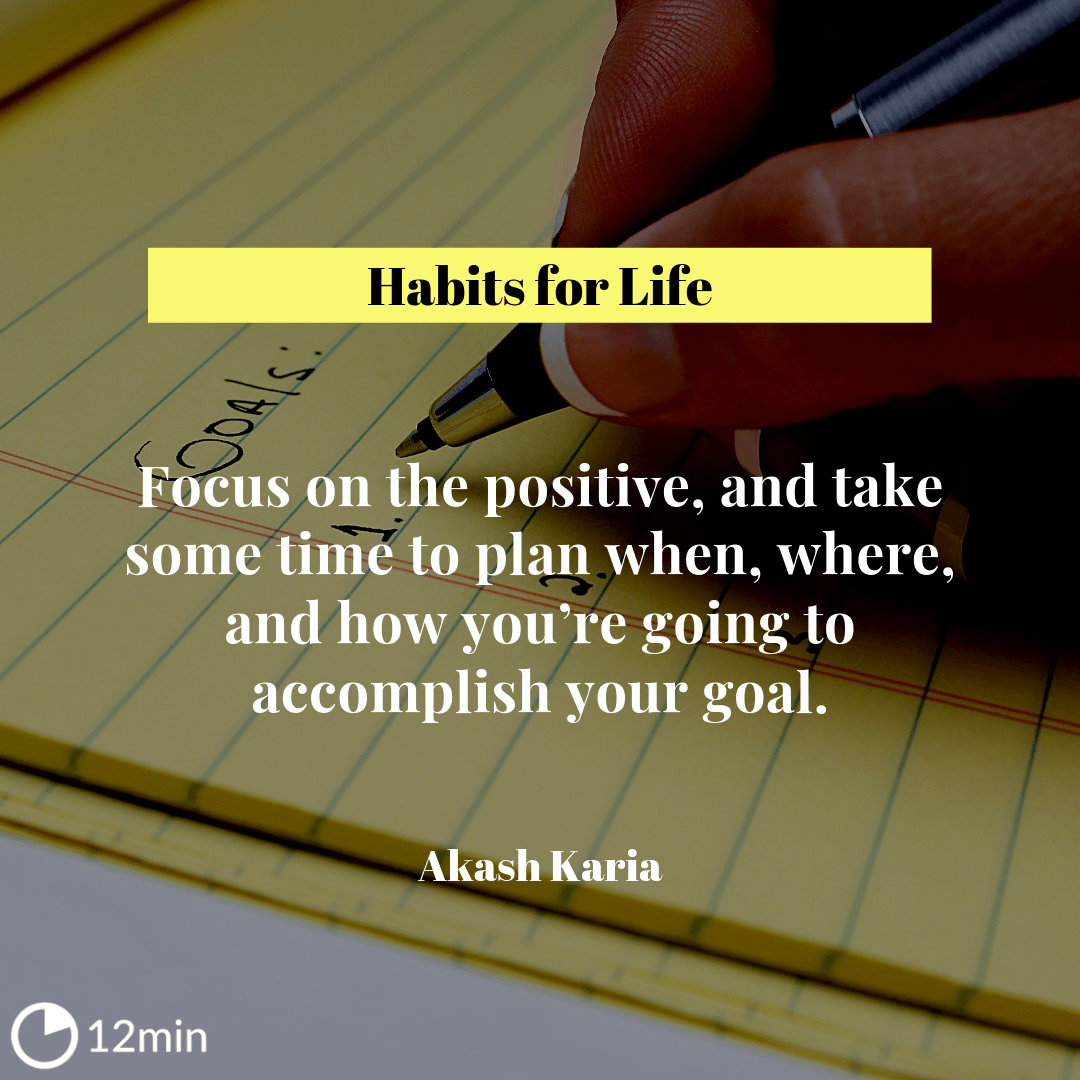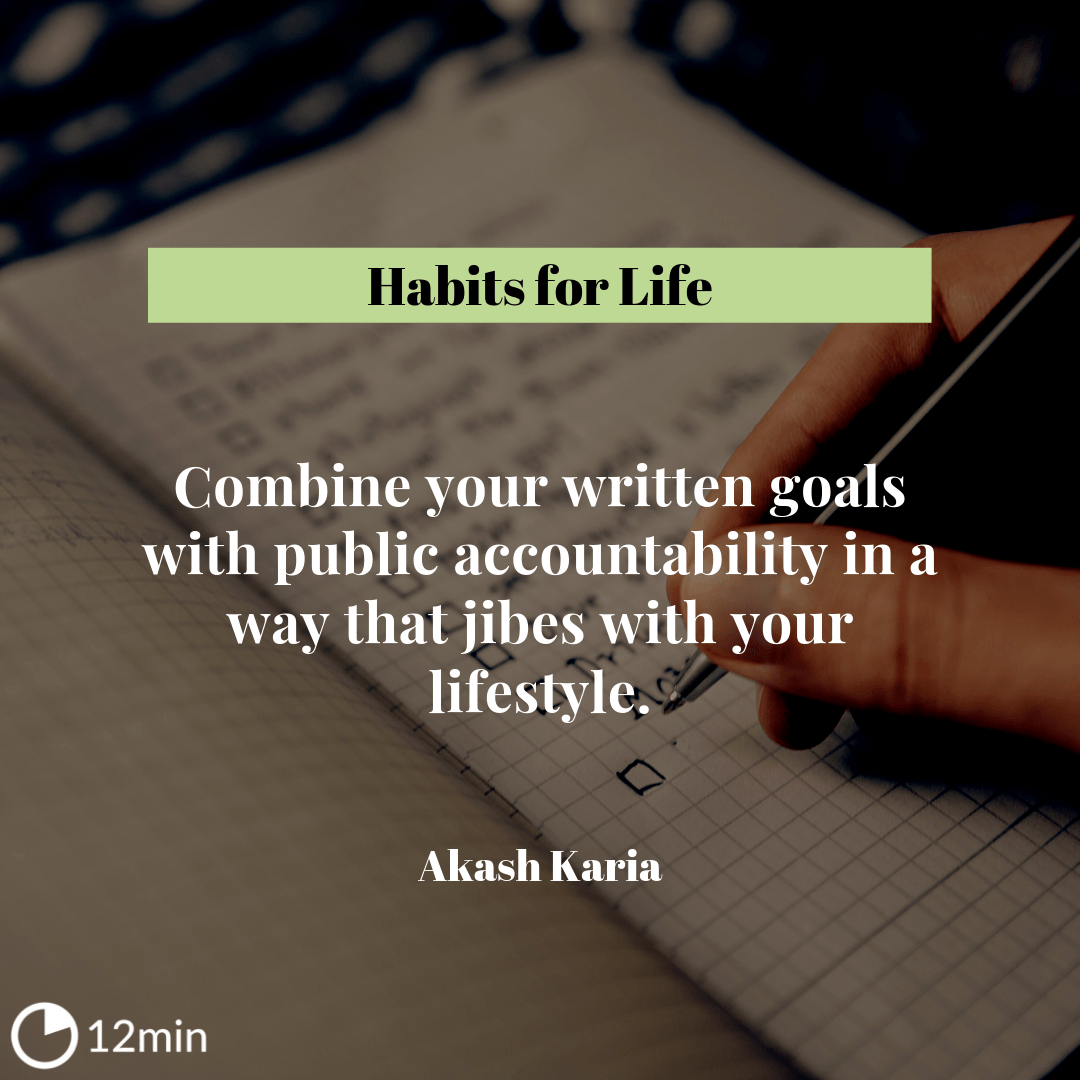Habits for Life Summary
4 min read ⌚
9 Steps for Building Habits that Stick
There’s a common saying, that the state of your bed is the state of your head. Every step we take reflects who we are. If I’m calm, the people I talk to will probably reply in a similar manner. This is due to the fact that our surroundings reflect our personality.
If we’re not fond of cleanliness, our room might be messy. Similarly, we tend to wait for instructions in every part of our lives.
Maybe it’s because great theories lead our practical lives. And who wouldn’t want to live a perfect life?
Defining ourselves is in our very nature: my name is; I live here; I have green eyes; I’m short; I’m a dreamy person, or maybe down-to-earth. This leads us to an author named Akash Karia.
THE SMALL & THE KEYSTONE HABIT / HABITS FOR LIFE
Small Habits + Keystone Habits = Big Results.
About Akash Karia
 Akash Karia is an award-winning speaker and peak performance coach. He currently lives in Tanzania, where he works as the Chief Commercial Officer of a multi-million dollar company.
Akash Karia is an award-winning speaker and peak performance coach. He currently lives in Tanzania, where he works as the Chief Commercial Officer of a multi-million dollar company.
“Habits for Life PDF Summary”
He regularly conducts keynotes, workshops, and seminars. His fans say he’s a phenomenal coach, and the knowledge gained from him is priceless.
I believe Karia is one of the few authors who try to highlight that we ourselves are not the problem. The great problem consists in our surroundings, generated by the lack of good instructions.
Akash Karia hints at our individual footprints; our steps create paths. That’s why his book is entitled Habits for Life: 9 Steps for Building Habits that Stick. It can be read as an instruction manual. He believes that our habits determine our surroundings.
Habits for Life: 9 Steps for Building Habits that Stick is a guidebook for creating order in our chaotic world, a world in which global communications can damage our self-images.
Karia’s main concept relies on two different branches: the small habit and the keystone habit.
Small habits are those which are so small that very little willpower is required to carry them out. Keystone habits, on the other hand, are the habits that set off a chain reaction of new and improved behaviors in other unrelated areas. These two habits create an equation like this:
Small Habits + Keystone Habits = Big Results.
Akash Karia gives tips for habits: read for 10 minutes; do two push-ups; drink a small glass of water with lunch; stretch for one minute; write 25 words in your journal; sit down at a piano; do one yoga pose; floss one tooth; laugh out loud once. These actions force you to do something and to do something regularly.
After discovering that you need to be more active, you start planning.
If you plan, you can then carry it out. If you succeed, you should reward yourself. If you lose, you should learn from it. A small habit could be putting on your running shoes. You’ve already won, whether you actually go for a run or not.
If you apply this small habit regularly, it’s more likely to start a chain of habits – a keystone habit.

There’s a vital concept of planning, called the “if-then goals”. It increases the chances of success. The main idea is to focus on the positive and take some time to plan ahead.
It’s also about “mental contrasting”. You have to be optimistic because positive thinking can fool your mind into thinking that you’ve already achieved something before you even start.
You may wonder why you never manage to finish the diet you start every January 1. It’s because major new habits require major willpower, and our brains associate willpower with pain. “Habits are so programmed in our neurological pathways that we don’t even know that they exist”, claims Akash Karia.
We move through our day like a plane on autopilot.
But any autopilot still needs someone to keep an eye on it, like a GPS relying on satellites. Our personal GPS could be a close friend. According to Karia, it’s important to have the added perspective of someone who can motivate you, and who understands the importance of consistency.
That’s why it’s best to choose someone whose characteristics you wish to emulate. The friend who lives off pizza and fried chicken probably won’t be the one encouraging you to stick with your plate of steamed vegetables.

If you can’t find a friend to motivate you, turn to your second best friend – the Internet. Writing down your goals and achievements is a successful strategy: blog it, Tweet it, put it on Facebook. You’ll have to adapt to your circumstances.
You can achieve your goals by reading Karia’s book step-by-step. That’s right! Habits for Life: 9 Steps for Building Habits that Stick consists of 9 steps to follow in order to achieve your goals.
I shouldn’t really end this summary with a beginning, except the book’s beginning is too good to not mention. Habits for Life: 9 Steps for Building Habits that Stick was written as a guidebook, and is based on one main theory. That theory is called the “66-Day Challenge”.
In the 1950s, a plastic surgeon named Maxwell Maltz began noticing that after operations, it took about 21 days for his patients to mentally adjust to their new images…
According to research, a new behavior can take anywhere from 18 to 254 days to become a habit… The average timeframe for habit formation, according to the study by Dr. Phillippa Lally, is 66.
Like this summary? We’d Like to invite you to download our free 12 min app, for more amazing summaries and audiobooks.
Our Critical Review
In creating an everyday routine, our duty is to increase our motivation and focus on the ‘big picture’.
Because it’s important that your chain of success is something visual, Akasha Karia highly recommends trying out the Jerry Seinfeld calendar.
Emir is the Head of Marketing at 12min. In his spare time, he loves to meditate and play soccer.







